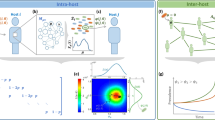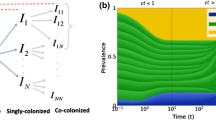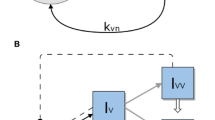Abstract
The basic reproduction ratio (R 0) is the expected number of secondary cases per primary in a totally susceptible population. In a baseline model, faced with an individual host strain pathogen virulence evolves to maximise R 0 which yields monomorphism. The basic depression ratio (D 0) is the amount by which the total population is decreased, per infected individual, due to the presence of infection. Again, in a baseline model, faced with an individual pathogen strain host resistance evolves to minimise D 0 which yields monomorphism. With this in mind we analyse the community dynamics of the interaction between R 0 and D 0 and show that multi-strain co-existence (polymorphism) is possible and we discuss the possibility of stable cycles occuring within the co-existence states. We show for co-existence, the number of host and pathogen strains present need to be identical in order to achieve stable equilibria. For polymorphic states we observe contingencies (outcome dependent on initial conditions) between both point equilibrium and sustained oscillations. Invasion criteria for host and pathogen strains are identified.
Similar content being viewed by others
References
Anderson R.M., May R.M. (1982) Directly transmitted infectious diseases: control by vaccination. Science 215: 1053–1060
Diekmann O., Heesterbeek J.A.P., Metz J.A.J. (1990) On the definition and computation of the basic reproduction ratio R 0 in models for infectious diseases in heterogeneous populations. J. Math. Biol. 28: 365–382
Bremermann H.J., Thieme H.R. (1989) A competitive exclusion principle for pathogen virulence. J. Math. Biol. 27: 179–190
Bowers R.G. (2001) The basic depression ratio of the host: the evolution of host resistance to microparasites. Proc R Soc B Biol Sci 268: 243–250
Boots M., Bowers R.G. (2003) Baseline criteria and the evolution of hosts and parasites: D 0, R 0 and competition for resources between strains. J. Theor. Biol. 223(3): 361–365
Armstrong R.A., McGehee R. (1980) Competitive exclusion. Am. Nat. 115: 151–170
Bergelson J., Dwyer G., Emerson J.J. (2001) Models and data on plant-enemy coevolution. Annu. Rev. Genet. 35: 469–499
Abrams P.A., Holt R.D. (2002) The Impact of consumer-resource cycles on the coexistence of competing consumers. Theor. Popul. Biol. 62: 281–295
Rothstein S.I. (1990) A model system for coevolution: Avian brood parasitism. Annu. Rev. Ecol. Syst. 21: 481–508
Li B., Smith H. (2001) How many species can two essential resources support?. SIAM J. Appl. Math. 62: 336–366
Thompson J.N., Nuismer S.L., Gomulkiewicz R. (2002) Coevolution and maladaptation. Integr. Comp. Biol. 42: 381–387
Holt R.D., Pickering J. (1985) Infectious disease and species coexistence: a model of Lotka-Volterra form. Am. Nat. 126(2): 196–211
Bowers R.G., Turner J. (1997) Community Structure and the interplay between interspecific infection and competition. J. Theor. Biol. 187: 95–109
Greenman J.V., Hudson P.H. (1999) Host exclusion and coexistence in apparent and direct competition: an application of bifurcation theory. Theor. Popul. Biol. 56: 48–64
Dieckmann U., Marrow P., Law R. (1995) Evolutionary cycling in predator-prey interactions: population dynamics and the Red Queen. J. Theor. Biol. 176: 91–102
Abrams P.A., Matsuda H. (1997) Fitness minimization and dynamic instability as a consequence of predator-prey coevolution. Evol. Ecol. 11: 1–20
Bowers R.G. (1999) A baseline model for the apparent competition between many host strains: the evolution of host resistance. J. Theor. Biol. 200: 65–75
Author information
Authors and Affiliations
Corresponding author
Rights and permissions
About this article
Cite this article
Bennett, R., Bowers, R.G. A baseline model for the co-evolution of hosts and pathogens. J. Math. Biol. 57, 791–809 (2008). https://doi.org/10.1007/s00285-008-0189-8
Received:
Revised:
Published:
Issue Date:
DOI: https://doi.org/10.1007/s00285-008-0189-8




